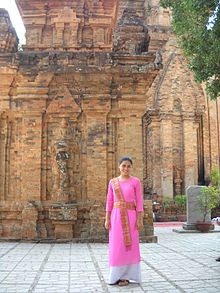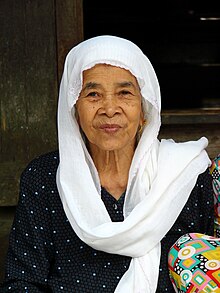Chams
[15] For a long time,[specify] researchers believed that the Chams had arrived by sea in the first millennium BC from Sumatra, Borneo and the Malay Peninsula, eventually settling in central modern Vietnam.[16] The original Chams are therefore the likely heirs of Austronesian navigators from Taiwan and Borneo, whose main activities are commerce, transport and perhaps also piracy.With having formed a thalassocracy leaving traces in written sources, they invested the ports at the start of important trade routes linking India, China and Indonesian islands.Historians are now no longer disputing in associating the Sa Huynh culture (1000 BC–200 AD) with the ancestors of the Cham people and other Chamic-speaking groups.[23] However, in Vietnamese mythology, which adopted the goddess after taking over the Champa kingdom, her name is Thiên Y A Na and she instead came from a humble peasant home somewhere in the Dai An Mountains, Khánh Hòa Province, spirits assisted her as she traveled to China on a floating log of sandalwood where she married a man of royalty and had two children.[24][25] Like countless other political entities of Southeast Asia, the Champa principalities underwent the process of Indianization since the early common era as a result of centuries of socio-economic interaction adopted and introduced cultural and institutional elements of India.In 1177, the Chams and their allies launched an attack from the lake Tonlé Sap and managed to sack the Khmer capital of Angkor.[36] Historical records in Indonesia showed the influence of Queen Dwarawati, a Muslim princess from the kingdom of Champa, toward her husband, Kertawijaya, the Seventh King of Majapahit Empire, so that the royal family of the Majapahit Empire eventually converted to Islam, which finally led to the conversion to Islam of the entire region.[37][38][39] Chams had trade and close cultural ties with the maritime kingdom of Srivijaya in the Malay Archipelago [citation needed].He came to Java in 1443 CE, in order to visit his aunt Queen Dwarawati, a princess of Champa who married to Kertawijaya (Brawijaya V), the King of Majapahit Empire.Poorly studied artifacts such as Islamic graves (which simply could have been ships' ballast) have been reexamined to show that they were, in fact, Tunisian and not Cham.[42] Between the rise of the Khmer Empire around 800 and the Vietnamese's territorial expansion southwards from Jiaozhi and, later, Đại Việt, Champa began to shrink.[43] In the Cham–Vietnamese War (1471), Champa suffered serious defeats at the hands of the Vietnamese, in which 120,000 people were either captured or killed, and the kingdom was reduced to a small enclave near Nha Trang with many Chams fleeing to Cambodia.[53] When the Ming dynasty in China fell, several thousand Chinese refugees fled south and extensively settled on Cham lands and in Cambodia.In response, the last Cham Muslim king, Pô Chien, gathered his people in the hinterland and fled south to Cambodia, while those along the coast migrated to Trengganu (Malaysia).[57] After Vietnam invaded and conquered Champa, Cambodia granted refuge to Cham Muslims escaping from Vietnamese conquest.[63] The second revolt led by Ja Thak Wa, a Bani cleric, resulting in the establishment of a Cham resistance which lasted from 1834 to 1835 until it was bloody crushed by Minh Mang's forces in July 1835.During the Vietnam War, a sizable number of Chams migrated to Peninsular Malaysia, where they were granted sanctuary by the Malaysian government out of sympathy for fellow Muslims; most of them have now assimilated with Malay cultures.[71] There is evidence that some Acehnese people of Aceh, Sumatra, Indonesia are descendants of Cham refugees who fled after defeat by the Vietnamese polity in the 15th century.Recent immigrants to Thailand are mainly students and workers, who preferably seek work and education in the southern Islamic Pattani, Narathiwat, Yala and Songkhla provinces.Many of these Cham refugees chose to settle in Malaysia, as they preferred to live in an Islamic country and had family ties in the Malaysian states of Kelantan and Terengganu.Criticism and concerns against Vietnamese, Indian, Malaysian governments and tourist corporations for misappropriating Cham heritage and ignoring living indigenous culture was made by the IOC and international scientists in recent years.The blending of various cultures has produced its own unique form through the prolific production of sculptures and architecture only seen at the Champa temple tower sites.[90] The Kan Imam San sect, accounting for about 10% of the Cambodian Cham minority and mainly centered around a few villages in the Tralach District of Kampong Chhnang Province and their historic mosque atop Phnom Oudong, have kept the use of the Western Cham script, akhar srak, alive — with grants from the US embassy for about a decade starting in 2007, the written form of Western Cham has moved from the preserve of a few elders to being taught in close to 20 classrooms with thousands of students exposed to some degree, albeit limited.It is often compared with other historical temple complexes in Southeast Asia, such as Borobudur of Java in Indonesia, Angkor Wat of Cambodia, Bagan of Myanmar and Ayutthaya of Thailand.Balamon Chams adhere to the old religion of their ancestor, an indigenized form of Hinduism that thrived since the ancient era of Kingdom of Champa in 5th century AD, whereas Cham Bani are adherents of a localized version of Shi'a Islam, including a minor element of Sufism, endured with Hindu-Chamic customs as early as around the 11th–13th century.[13] As Muslim merchants of Arab and of Persian origin stopped along the Vietnam coast en route to China, Islam began to influence Cham civilization.[30] It is generally assumed that Islam came to mainland Southeast Asia much later than its arrival in China during the Tang dynasty (618–907) and that Arab traders in the region came into direct contact only with the Chams and not others.[104][105][106] Chams eat three meals a day – breakfast, lunch and dinner – with rice, maize, sweet potato and beans being the staple food.Another type of mắm that may have originally been a Cham product is mắm ruốc [vi], which has become a famous condiment in modern-day Central Vietnam eaten with raw vegetables, herbs and boiled pork and used as an essential ingredient for the Central Vietnamese noodle dish bún bò Huế.














Cham AlbaniansChams (disambiguation)Nha TrangCambodiaVietnamMalaysiaThailandUnited StatesFranceVietnameseSunni IslamKan Imam SanHinduismTheravada BuddhismUtsulsAustronesian peoplesAcehneseAustronesianSoutheast Asiacentral VietnamKhmer EmpireChampaMuslimmatriarchyHainan IslandChamic languagesMalayo-PolynesianAustronesian familyKhmer RougeCambodian genocideSumatraBorneoMalay PeninsulaTaiwanChamicthalassocracyIndonesianSa Huynh culturepeninsular Southeast AsiaAustroasiatic language familyMon peopleKhmer peoplemaritime Southeast Asiacreation mythLady Po NagarThiên Y A NaKhánh Hòa ProvincegarudaIndianizationGujaratAngkorAd-DimashqiMuslimsUthmanUmayyadsHajjajDaoyi ZhilüeQuanzhouTonlé SapJayavarman VIIBoxer CodexMalaccaMalacca SultanateJohor SultanatePortuguese occupation of MalaccaJawi alphabetChau DocIndonesiaMajapahit EmpireTrowulanBabad Tanah JawiBrawijayaSrivijayaMalay ArchipelagoSunan AmpelWali SangaMaulana Malik IbrahimJavaneseMasjid Agung DemakSunan KalijagaAmpel MosqueSurabayaEast Javaterritorial expansion southwardsJiaozhiĐại ViệtCham–Vietnamese War (1471)matrilinealVietnamese ceramicsMing dynastydefeating the Spanish invasion of CambodiaCau Bana Cand RamadhipatiCambodian–Dutch WarNguyen LordsChams settled in BangkokPandurangaMinh MạngTrengganuHainanMekong BasinPhan Thiếtconquered ChampaKatip SumatKelantanJa Thak WaCham resistanceVietnam WarViet MinhOperation Passage to FreedomDemocratic Republic of VietnamRepublic of VietnamNgo Dinh DiemCommunist Party of VietnamVoice of Việt NamRhadéBahnarIndochina Communist PartyCommunist Party of KampucheaFront for the Liberation of ChampaPeninsular MalaysiaMalaysian governmentagarwoodPahangDemocratic KampucheaChineseChâu Đốc